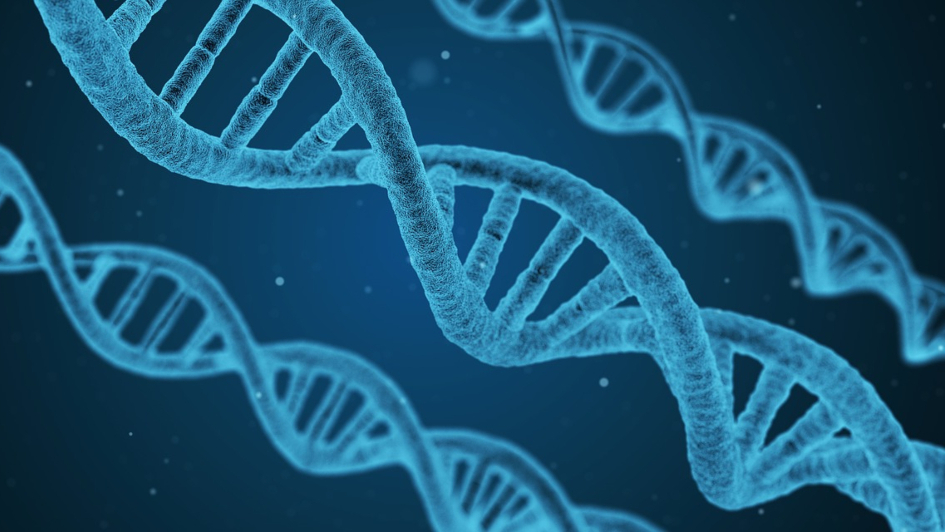
Image: DNA double helix (computer visualisation). Credit: Arek Socha via Pixabay
Damage to DNA is the basic cause of cancer. As you read this, many of your cells are producing new DNA, and some of that DNA will contain errors in its sequence, as the cell makes small mistakes in production.
Your cells are very good at spotting these errors, and dealing with them swiftly and safely by either pushing a pre-programmed ‘self-destruct’ button if the error is too serious to be rectified or repairing the damage with specific proteins that can fix the mistakes.
Sometimes, errors in DNA slip through the net, and cancer can develop as cells replicate out of control. While DNA damage is a strength for cancer, it also represents a fundamental weakness, which can be exploited in developing cancer treatments.
Weakness and strength
Weakness and strength are very closely aligned in nature. Scientists at the ICR work hard to try to turn cancer’s weaknesses into our strengths when it comes to developing drugs. It takes many teams, many years and many success and failures to produce results that help develop smarter, kinder treatments.
A drug developed at the ICR, olaparib, also capitalises on targeting DNA repair mechanisms. A precision medicine, it works by selectively targeting and killing cancer cells which have faulty DNA repair machinery.
The drug’s discovery and development were underpinned by more than twenty years of research at the ICR across many teams of scientists and clinicians.
Cancers which arise from faulty BRCA1 or BRCA2 genes are vulnerable to these drugs, meaning they can be used in breast, ovarian and prostate cancers in patients with faults in these genes.
The ICR story
The BRCA genes are involved in DNA repair – a discovery made by former ICR Chief Executive Professor Alan Ashworth together with and colleagues from across the ICR. Their key role in repairing DNA means that cancers with BRCA mutations are particularly vulnerable to DNA damage.
Olaparib is a type of drug known as a PARP inhibitor. Cells with faulty BRCA genes already have a hard time repairing DNA damage, and they rely on enzymes called PARP for all their repair needs. Stopping PARP takes away their emergency repair kit, and causes cancer cells to die, while healthy cells survive.
The drug had already been approved by US and European drug regulators for use in ovarian and breast cancers and last year saw the drug gain approval in the USA and Europe for use in advanced prostate cancer.
Professor Johann de Bono, Professor of Experimental Cancer Medicine at The Institute of Cancer Research, London, and Consultant Medical Oncologist at The Royal Marsden NHS Foundation Trust, said:
“Olaparib has now become one of the first precision medicines for prostate cancer. It is the perfect example of how understanding the genetics of a patient and their cancer can be used to target the disease’s Achilles heel and personalise treatment.
“It is tremendously exciting to see this drug being approved in the US for this group of patients. This is the fruit of so much hard work by scientists at the ICR over many decades.”
Trialling the latest treatments
A recent phase I clinical trial, led by Professor Johann de Bono, together with colleagues from The Royal Marsden, tested a drug called berzosertib, the first in a new family of drugs blocking a key DNA repair protein called ATR.
Typically, in a phase I trial, scientists are only looking to establish a safe dose to use and they don’t expect to see any clinical benefit in such early stages of research.
But incredibly, in this trial, over half of patients given berzosertib saw their cancer stop growing. Some patients were given the drug on its own, while others were given the drug in combination with chemotherapy.
Patients who had the two in combination saw an even greater impact on their tumours, indicating the drug allows us to tame cancer growth and kick it while it’s down.
These are but some examples of the outstanding work done by scientists and clinicians to develop treatments for cancer which require a deep understanding of the fundamental biology of cancer. It is only in thoroughly understanding the problem that we can develop the most effective solutions.